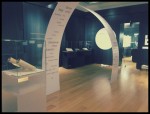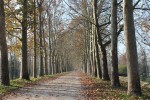Massari Park
The Massari Park takes its name from the adjacent palace built at the end of the sixteenth century and is the largest among the public gardens within the city walls.
The largest public park within the city walls, covering about four hectares, Parco Massari gets its name from the adjacent late-sixteenth-century building. Designed in 1780 by Ferrara architect Luigi Bertelli for Marquis Camillo Bevilacqua (1745-1821), this important garden was known for the many sculptures that decorated it and the variety of citrus trees and flowering plants that scented the air of its magnificent paths. Around the mid-1800s, the Massari Counts purchased the building, modifying the entire complex to create an English garden. The layout of the flower beds dates to the nineteenth century, and many of the trees are hundreds of years old: in addition to the two Lebanon cedars (1) at the entrance, there are a few yews, a large ginkgo biloba and the giant English oak near the entry gate on Ercole I of Este Avenue (Corso Ercole I d’Este). The Municipality of Ferrara has used it as a public park since 1936.
Parco Massari is known for having inspired Giorgio Bassani (1916-2000) in his description of the legendary garden of the Finzi-Contini family, a key setting in his novel The Garden of the Finzi-Continis. It is important to note that the author's literary representation was actually based on the Garden of Ninfa, grafting visions of a garden that is hundreds of kilometres away onto his imaginary version of Ferrara. His daughter, Paola Bassani, explained: ‘My father loved paradoxes and sometimes embodied them. I realised that the garden so intrinsically linked to his most famous novel is not, as one might believe from the pages of his book, in Corso Ercole I d’Este, in the heart of the city, but hundreds of kilometres from Ferrara, in Ninfa. It’s a property owned by the royal Caetani siblings, Roffredo and Marguerite. The latter was the director of Botteghe Oscure, a magazine that my father worked for at length. ...My father was deeply struck and fascinated by the Gardens of Ninfa, to the point that he internalised the gardens for many years, then dropped them in Ferrara, or I should say, he had the courage to drop them in Ferrara. That’s right. He who said he was a crusader, wanting to talk about Ferrara and its historical and topographical reality, put the Gardens of Ninfa in the city of Ferrara! As he said in an interview, he allowed himself this rather large transgression: ‘I took a few liberties’, he said, and then provided Ninfa as an example’. (P. Bassani, Se Avessi una Piccola Casa Mia. Giorgio Bassani, Il Racconto di una Figlia, La Nave di Teseo, Milan 2016, p. 29s.)
Note
(1) Servizio protezione flora e fauna, oasi e zone protette della Provincia di Ferrara (a cura di), I grandi alberi della provincia di Ferrara, Provincia di Ferrara, Ferrara 2008
The three Cedars of Lebanon and the Persian Ironwood in the center of the park, due to their characteristics, have been included in the first List of monumental trees in Italy, pursuant to Article 7 of the law dated January 14, 2013, No. 10
Bibliography
- Frizzi, Antonio, Memorie storiche della nobile famiglia Bevilacqua, Dalla Reale Stamperia, Parma 1779 Vai al testo digitalizzato
- Servizio protezione flora e fauna, oasi e zone protette della Provincia di Ferrara (a cura di), I grandi alberi della provincia di Ferrara, Provincia di Ferrara, Ferrara 2008
- Paola Bassani, Se avessi una piccola casa mia. Giorgio Bassani, il racconto di una figlia, La nave di Teseo, Milano 2016
Sitography
- http://www.ferraraterraeacqua.it/it/ferrara/scopri-il-territorio/ambiente-e-natura/parchi-urbani-orti-botanici/parco-massari
- http://artemoderna.comune.fe.it/1839/palazzo-massari
- http://artemoderna.comune.fe.it/modules/core/lib/d.php?c=pJPT5
- www.comune.comacchio.fe.it/index.php/content/download/7486/93580/file/ANECDOTA%20-%20I%20quaderni%20dell%20Biblioteca%20Muratori,%20Comacchio%20-%20Anno%20XXII%20n.1-2%20-%20Dicembre%202012%20parte%205.pdf
Related Subjects
Related Themes
Related Itineraries
Compiling entity
- MEIS Museo Nazionale dell’Ebraismo Italiano e della Shoah
- Assessorato alla Cultura e al Turismo, Comune di Ferrara
Author
- Sharon Reichel
- Paola Boccalatte
- Barbara Pizzo





